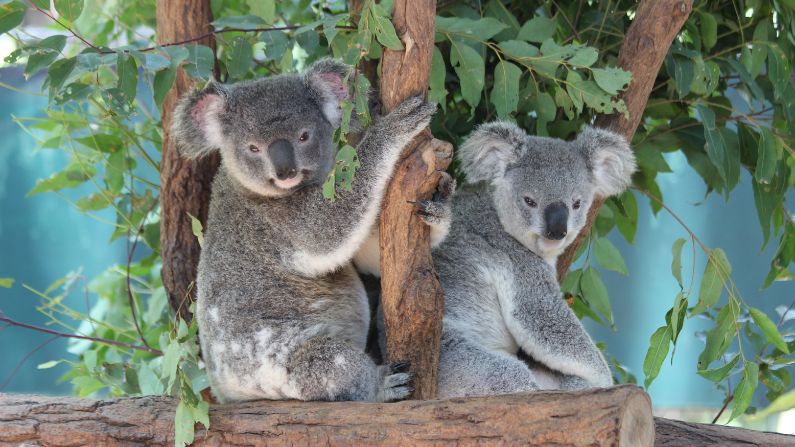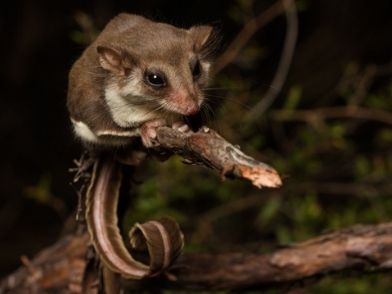Koala
© Canva NFP
The koala (Phascolarctos cinereus) is the largest arboreal folivore found in Australia, with a lifestyle adapted to life in the trees. It is the only extant member of the family Phascolarctidae but debate continues amongst researchers as to whether there are two or three subspecies, or whether there are any at all. The koala feeds almost exclusively on leaves of Eucalyptus and allied genera such as Corymbia, Angophora and Lophostemon, which are potentially harmful to some other mammals. Koalas are able to detoxify eucalyptus oil and obtain enough nutrients from the leaves to live. Their caecum (intestine) is the largest of all mammals. The caecum is a large fermentation chamber, where leaves (cellulose) are digested by micro-organisms.
Quick facts
COMMON NAME:
Koala
SCIENTIFIC NAME:
Phascolarctos cinereus
FAMILY:
Phascolarctidae
RECOVERY PLAN:
ALSO KNOWN AS:
koala bear, monkey bear, native bear
QLD CONSERVATION STATUS:
Endangered
NATIONAL CONSERVATION STATUS:
Endangered
Did you know?
The koala’s scientific name comes from the Greek words ‘phaskolos’ meaning pouch, ‘arktos’ meaning bear, and the Latin word ‘cinereus’, which means ash-coloured. Its Australian indigenous name is koobor which means ‘does not drink water.’ Its common name ‘koala’ is an aboriginal name from the Hawkesbury River district (near Sydney).

Threats to koalas
Known threats:
- Loss, modification and fragmentation of habitat
- Vehicle strikes
- Predation by domestic and feral dogs
- Disease — there are four main diseases generally associated with infection by chlamydiophyla (i) conjunctivitis, which can lead to blindness, (ii) pneumonia, (iii) urinary tract infections, (iv) reproductive tract infections (cystitis).
- Extreme wildfire — kills or scorches the tree canopy and kills or severely burns koalas. Fragmented populations are at high risk of local extinction by wildfires.
- Wasting disease (nitrogen deficiency) — in times of prolonged drought, Eucalyptus leaves contain less digestible nitrogen and koalas may die with a stomach full of leaves.
Presumed threats:
- Climate change — increased temperatures may reduce the nitrogen and water content of Eucalypt foliage and increase variability in rainfall, with prolonged droughts.
Home range
- Varies with the quality of habitat with larger home ranges in poorer habitat.
- Ranges from less than 2 ha to 150 ha in size. In good habitat areas of South East Queensland, females have a home range of 5-8 ha and males 9-22 ha.
- Male koalas generally have a larger home range than females.
- Home ranges can overlap.
Distribution
- Fragmented distribution throughout eastern Australia.
- Found in Queensland, New South Wales, Victoria, and South Australia.
- Extends as far north as Atherton Tablelands (west of Cairns), and as far south as the islands off Victoria and South Australia.
- Introduced to some islands (Kangaroo, Phillip Islands) where populations have become over-abundant, leading to defoliation of food trees such as the manna gum — ultimately resulting in the starvation and death of koalas.
- Population in South Australia became extinct in the 1930s and since then all have been introduced from Victorian animals.
- Majority of populations in Victoria have been supplemented by translocations.
Description
Koalas have large, furry ears, a prominent black nose and a very small tail. The northern and southern populations differ in appearance.
- The southern population is heavier, with males reaching 12 kg and females 8.5 kg, while northern males reach a maximum of 8-9 kg and females 5-6 kg. They have darker fur with brown colouring, and the fur is longer and thicker; these are adaptations to the cooler climate.
- The northern population is a lighter grey colour, with more prominent light ventral colouring.
The koala is adapted for movement in the trees, with long and strong digits and claws. The koala’s hands have two ‘thumbs’, and their feet have a joined second and third digit with two claws used for grooming.
Signs
- Scats:
- Small, oval-shaped with well-digested small particles.
- Very hard and dry.
- Often in piles on the ground under Eucalypt trees or in branches.
- Small branches often cover the ground under Eucalypt trees, which indicates that koalas have been feeding in that tree.
Habitat
- Eucalyptus woodlands and forests of eastern Australia.
- Are also known to rest in non-eucalypt trees.
Ecology
Life history and behaviour
- Generally solitary.
- Mostly nocturnal (inactive for most of the day).
- Males survive for up to 10-12 years and females 12-14 in the wild but may survive for up to 24 years in captivity.
Breeding
- Mating season extends from early spring to midsummer.
- Gestation period is approximately 35 days.
- Female usually produces one young per year.
- Newborn koala is approximately 19 mm long and 5.5 gms in weight.
- Newborn climbs unaided to the pouch and attaches to a teat.
- Mother produces a special form of faeces known as ‘pap’ which inoculates the gut with bacteria required for its adult diet of Eucalyptus leaves.
- 6 months later, young emerge from pouch and has grown around 20 cm in length.
- Joey is carried on the mother’s back for a further 6 months.
- During the breeding season, males advertise by bellowing and scent marking from a gland on their chest.
Food
- Eucalyptus and allied genera leaves.
- Very selective feeders, preferring young foliage at the tips of the branches.
- Very poor source of energy which is high in toxic compounds — therefore, koalas have a very low metabolic rate.
- Consume water very rarely.
- Also known to feed on non-eucalypt species, but these contribute a very minor proportion to the diet.
More information
Publications & papers
- Dique, D.S., J. Thompson., H.J. Preece., D.L. de Villiers., F.N. Carrick. 2003. Dispersal patterns in a regional koala population in south-east Queensland. Wildlife Research 30(3): 281-290.
- Dique, D.S., J. Thompson., H.J. Preece., G.C. Penfold., D.L. de Villiers., R.S. Leslie. 2003. Koala mortality on roads in south-east Queensland: the koala speed-zone trial. Wildlife Research30(4): 419-426.
- Dique, D. S., H. J. Preece, J. Thompson, & D. L. De Villiers. (2004). Determining the Distribution and Abundance of a Regional Koala Population in South-East Queensland for Conservation Management. Wildlife Research, 31: 109-117.
- Ellis, W., Melzer, A. and Bercovitch, F. (2009). Spatiotemporal dynamics of habitat use by koalas: the checkerboard model. Behav. Ecol. Sociobiol. 63(8): 1181–1188.
- Jackson, S. M. (ed). 2003. Australian Mammals: Biology and Captive Management. CSIRO Publishing, Melbourne.
- Jackson, S.M. 2007. Koala: Origins of an Icon. Allen and Unwin, Sydney. 337p.
- McAlpine, C.A., Callaghan, J.G., Lunney, D., Bowen, M.E., Rhodes, J.R., Mitchell, D.L., and Possingham, H.P. 2005. Conserving south-east Queensland koalas: how much habitat is enough? Pages 11-17 (part II) in G. L. Siepen and D. Jones, editors. Proceedings of the 2005 south east Queensland biodiversity conference. University of Queensland, Gatton Campus.
- McAlpine, C.A., J.R. Rhodes., J.G. Callaghan., M.E. Bowen., D. Lunney., D.L. Mitchell., D.V. Pullar., H.P. Possingham. 2006. The importance of forest area and configuration relative to local habitat factors for conserving forest mammals: A case study of koalas in Queensland, Australia. Biological Conservation 132(2): 153-165.
- Sullivan. B.J., G.S. Baxter., A.T. Lisle., L. Pahl., W.M. Norris. 2004. Low-density koala (Phascolarctos cinereus) populations in the mulgalands of south-west Queensland. IV. Abundance and conservation status. Wildlife Research 31: 19-29.
- Woodward, W. , Ellis, W. A., Carrick, F. N., Tanizaki, M., Bowen D. and Smith, P. 2008. Koalas on North Stradbroke Island: diet, tree use and reconstructed landscapes. Wildlife Research 35(7): 606–611.




